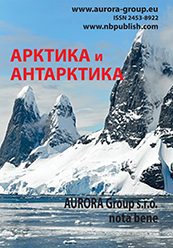Natural resources of the Arctic and Antarctica
Reference:
Kaverin, D.A., Sudakova, M.S., Khomutov, A.V., Khairullin, R.R., Fakashchuk, N.Y., Pastukhov, A.V. (2022). Application of georadiolocation to assess the influence of the highway on the depth of permafrost in polygonal swamps of the North of Western Siberia. Arctic and Antarctica, 2, 1Ц12. https://doi.org/10.7256/2453-8922.2022.2.37964
Abstract:
The results of the application of geo-radar profiling for the study of soils and underlying rocks of polygonal bogs of the Pur-Taz interfluve (North of Western Siberia), functioning in natural and anthropogenic disturbed conditions, are presented. The research area belongs to the southern tundra with a predominantly continuous distribution of permafrost rocks. The construction of highways in the North of Russia is one of the main factors of anthropogenic impact on the tundra geosystems of the cryolithozone, affecting the temperature regimes of soils and the depth of permafrost. The features of spatial differentiation of the depth of occurrence of permafrost rocks on the site of polygonal swamps intersected by a federal highway were determined by the methods of geo-radar profiling. Georadiolactic profiling made it possible to determine the configuration of the depth of the permafrost roof both in natural and anthropogenic disturbed areas of polygonal swamps. The maximum lowering of the permafrost roof is determined at the base of the road embankment and does not exceed a depth of three meters. Despite the deep occurrence of the MMP roof under the road embankment, the thickness of the thawed buried peat horizons here is similar to that of the seasonally shallow layer of undisturbed peat polygons. The features of spatial differentiation of the depth of the permafrost roof in the polygonal swamps intersected by the bulk highway in the North of Western Siberia are similar to those characteristic of regions with a continuous low-temperature cryolithozone. The method of manual probing of the permafrost roof was used to verify the results of geo-radar profiling within undisturbed areas.
Keywords:
Western Siberia, southern tundra, anthropogenic disturbances, highway, manual sensing, tundra soils, seasonally small layer, permafrost rocks, georadar, polygonal swamps
Natural resources of the Arctic and Antarctica
Reference:
Galkin, A., Pankov, V.Y. (2022). The effect of the iciness of the soil on the depth of thawing of the road base. Arctic and Antarctica, 2, 13Ц19. https://doi.org/10.7256/2453-8922.2022.2.38103
Abstract:
One of the important parameters determining technical solutions in the design of highways in the cryolithozone is the depth of thawing of the soils of the road base. The aim of the work was to quantify the degree of influence of the iciness of the soil foundations of roads in the cryolithozone on the depth of their seasonal thawing. For the analysis, the classical formula for calculating the thawing depth for bodies of plane symmetry, obtained by solving the single-phase Stefan problem, was used. The results of calculations are presented in the form of 2D and 3D graphs, which allow us to visually assess the effect of the iciness of the soil and the degree of its change during the operation of the road on the depth of thawing of the road base. It was found, in particular, that the degree of change in the depth of thawing at the same value of the increase in ice content in different ranges (for example, from 10 to 20% and from 30 to 40%) for the considered typical case of the ground base of the cryolithozone decreases by almost 1.3 times. It is shown that the greater the initial iciness of the soil, the degree of decrease in the depth of thawing when the iciness changes by a constant value will be less. A 3D graph was built to determine the depth of thawing of the soils of the active layer of the road base in a wide range of possible changes in ice content during the construction and use of the highway. The availability of a schedule allows to quickly assess possible options for changing the depth of thawing and make a correct, informed technical decision when designing the road. For example, when assessing the need to use a special heat-protective layer in road clothing. Further directions of research in this area should be aimed at studying the effect of humidity (iciness) of dispersed soils on the depth of thawing of road foundations, taking into account the dependence of the density and thermal conductivity of the soil on the iciness.
Keywords:
degree of change, designing, 3D graph, iciness, thawing depth, forecast, permafrost, automobile road, temperature, calculation
Permafrost and ground ice of the Arctic, Antarctic and mountain regions
Reference:
Budantseva, N.A. (2022). New Holocene formal subdivision Ц application for the Russian Arctic. Arctic and Antarctica, 2, 20Ц35. https://doi.org/10.7256/2453-8922.2022.2.38390
Abstract:
The subject of the study is a new formal subdivision of Holocene epoch applied to the northern regions of the Russian permafrost. The following criteria are considered: criteria for the modern allocation of three calendar periods of the Holocene; comparison with the Blitt-Sernander scheme; comparison with the three-term division of the Holocene for the Russian Arctic, proposed by Yu.K.Vasilchuk. In 2008, the International Commission on Stratigraphy (IUGS) established the boundary between the Holocene and the Neo-Pleistocene at the turn of about 11,700 calibrated years ago (cal. l. n.). In 2018, in addition to the well-known Blitt-Sernander division, the Holocene was divided by IUGS into three tiers: Greenland (from 11,700 to 8,200 cal. years ago), North Grippian (from 8200 to 4200 cal. years ago) and Meghalayan (beginning 4200 cal. years ago). The features of the development of polygonal vein arrays during three Holocene periods were established and the average January air temperatures for four key regions of the Russian cryolithozone were reconstructed - the north of the European part of Russia, the north of Western Siberia, the lower reaches of the Kolyma River and the east of Chukotka. It is shown that, taking into account the new division of the Holocene, the Greenland and North Grippian periods of the Holocene (between 11.7 and 4.2 thousand years ago) are the stage of the most active development of peat bogs and the simultaneous formation of reЦvein ice in them. The Meghalayan Holocene period was characterized by a marked decrease in the development of peatlands, but syngenetic growth of re-vein ice continued within the emerging floodplains and laids, especially within the torn-off areas. The reconstructed average January air temperatures for four key regions of the Russian cryolithozone showed that the Greenland and North Grippian periods of the Holocene were characterized by slightly higher values (on average 1-2 ∞C higher) than the Meghalayan, with the exception of eastern Chukotka, for which an increase in the average January air temperature during the Meghalayan period was noted.
Keywords:
eastern Chukotka, polygonal ice wedges, average January air temperature, The European North of Russia, north of Western Siberia, lower Kolyma River, meghalayan period, The Northern Grippian period, Greenland period, new division of the Holocene
Permafrost and ground ice of the Arctic, Antarctic and mountain regions
Reference:
Khimenkov, A.N., Gagarin, V.E. (2022). Approaches to the study of deformations in permafrost soils. Arctic and Antarctica, 2, 36Ц65. https://doi.org/10.7256/2453-8922.2022.2.38229
Abstract:
The object of the study is the processes of metamorphism of frozen rocks, including structural restructuring, as well as plastic and brittle deformations of underground ice. In geocryology, many experts note the importance of considering the processes of deformation of frozen rocks. At the same time, the deformed rocks themselves do not stand out in a separate category, which makes it difficult to study the development of cryogenic geosystems after their formation. The main method used in this article is the analysis of the results of previous studies by various authors on the topic under consideration. The theoretical basis of the proposed approach is the provisions developed within the framework of the mechanics of frozen soils and structural ice science. The synthesis of the analyzed materials was carried out on the basis of a geosystem approach. In the proposed work, for the first time, a comparative analysis of structural deformations of various kinds of cryogenic formations was carried out. The relevance of the topic under consideration is due to the need to study the patterns of deformation of frozen rocks in natural conditions. Theoretically, this is important for a deeper understanding of the processes occurring in the cryolithozone. For practical purposes, work in this direction will allow us to more accurately assess the possibility of the development of dangerous engineering-geological processes with man-made impacts on frozen rocks. Changes in the structure of frozen rocks continue after the formation of the primary structure. Deformations, that is, violations of the primary addition, are an integral part of the structure of frozen rocks. Data on deformations of the primary cryogenic structure provide information about the history of the development of cryogenic geosystems that have already been formed. It is necessary to develop a classification of textural and structural deformations of the cryogenic structure of frozen rocks, in which a special type should be distinguished - metamorphosed ice formations. It is necessary to develop methods of structural and deformation analysis that allow establishing links between the observed deformations of the cryogenic structure and the processes occurring in frozen rocks.
Keywords:
dissociation of gas hydrates, ice flow, breaking deformations, plastic deformations, cryogenic textures, permafrost rocks, gas filtration, stages of development, segregation ice, injectable ice
Permafrost and ground ice of the Arctic, Antarctic and mountain regions
Reference:
Vasil'chuk, A.C., Vasil'chuk, Y.K., Budantseva, N.A., Vasil'chuk, J.Y., Ginzburg, A.P., Bludushkina, L.B., Slyshkina, H.S. (2022). Carbon-to-nitrogen ratio in late Pleistocene ice wedges and in modern soils in the Batagay megaslump, north of Yakutia. Arctic and Antarctica, 2, 66Ц81. https://doi.org/10.7256/2453-8922.2022.2.38381
Abstract:
The content of carbon and nitrogen, as well as the carbon-to-nitrogen ratio in the genetic horizons of the soil cover, yedoma deposits and in organic residues in syngenetic ice wedges (IW) of the upper IW complex of the Batagay megaslump were studied. The studied soils belong to the silty-loam Spodic Cryosol (Dystric,Humic) and post-pyrogenic Spodic Cryosol (Dystric,Humic). To study the carbon and nitrogen content, ice wedges of the first and second tiers of the upper IW complex were tested. The highest values of the C/N ratio were obtained in the upper horizon of the silty- loam Spodic Cryosol (Dystric, Humic) near the Batagay megaslump. The average value of the carbon content in the ice wedges of the Batagay yedoma is of 0.13 mol, the maximum is 0.36 mol, the minimum carbon content is 0.06 mol, the average nitrogen content is of 0.04 mol, maximum 0.12 mol, minimum 0.02 mol. For the entire data array of ice wedges, the value of C/N is of average 3.90, maximum 6.96, minimum 1.05.
Keywords:
Yakutia, Yana River Valley, Batagay, soil, late Pleistocene, ice wedge, yedoma, permafrost rocks, nitrogen, carbon
 This work is licensed under a Creative Commons Attribution-NonCommercial 4.0 International License.
This work is licensed under a Creative Commons Attribution-NonCommercial 4.0 International License.
 Eng
Eng













 © 1998 Ц 2025 Nota Bene. Publishing Technologies. NB-Media Ltd.
© 1998 Ц 2025 Nota Bene. Publishing Technologies. NB-Media Ltd.




